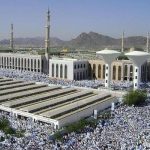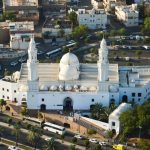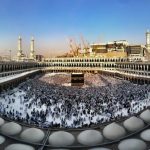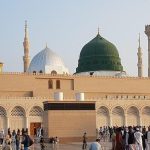At Umrah International, we understand the profound significance of religious journeys. This blog delves deep into the life of ‘Isa ibn Maryam (Jesus son of Mary), exploring his miraculous birth and the divine purpose he fulfilled.
1. Introduction
‘Isa ibn Maryam is one of the most revered figures in Islamic tradition, regarded as a prophet, a messenger, and a significant spiritual figure. His story is marked by miraculous events, profound teachings, and a legacy that transcends religious boundaries. In Islam, ‘Isa is celebrated not only for his miraculous birth but also for his message of monotheism, compassion, and justice. This narrative aims to provide a comprehensive exploration of his life, teachings, and the enduring impact he has had on both Islamic and broader religious contexts.
2. Prophetic Announcement
The story of ‘Isa begins with an extraordinary announcement. In Islamic belief, the angel Gabriel (Jibril) is entrusted with the task of delivering the news of his forthcoming birth to Maryam (Mary). This moment is described in the Qur’an, where it highlights the divine nature of this announcement:
“O Maryam, indeed Allah gives you good tidings of a word from Him, whose name will be the Messiah, ‘Isa, the son of Maryam…” (Qur’an 3:45)
This verse encapsulates not only the miraculous conception but also emphasizes the honor bestowed upon Maryam as the mother of a prophet. The title “Messiah” carries significant weight, referring to a figure destined to bring guidance and salvation.
3. Understanding the Title: The Messiah
The term “Messiah” (Arabic: Al-Masih) signifies one who is anointed and chosen by God. In both Islamic and Christian contexts, the Messiah represents hope and redemption. In Islam, ‘Isa’s role as the Messiah includes:
- Bringer of Guidance: ‘Isa’s mission was to guide the Children of Israel back to the path of righteousness.
- Miraculous Nature: His miracles, such as healing the sick and raising the dead, serve as signs of his divine mission.
- Symbol of Hope: For Muslims, ‘Isa represents hope not just for his community but for all humanity, as his teachings emphasize love, justice, and mercy.
Understanding these nuances helps to appreciate the profound impact of ‘Isa’s life and mission.
4. The Miraculous Birth of ‘Isa
The birth of ‘Isa is a pivotal event, celebrated for its miraculous nature. According to Islamic tradition, Maryam was a chaste and devoted woman, chosen by Allah to bear a child without a father. The Qur’an details this miraculous birth:
“So she conceived him, and she withdrew with him to a remote place.” (Qur’an 19:22)
The moment of childbirth is depicted as both a moment of joy and immense struggle for Maryam. The birthing scene beneath the palm tree symbolizes strength and vulnerability:
“And the pains of childbirth drove her to the trunk of a palm tree. She said, ‘Oh, I wish I had died before this and was in oblivion, forgotten.'” (Qur’an 19:23)
This passage underscores the emotional and physical challenges Maryam faced, reflecting her unwavering faith in Allah’s plan.
5. The Pregnancy: A Unique Experience
Maryam’s pregnancy was not just a personal journey but also a societal challenge. As a young woman in her community, the stigma of an unwed pregnancy posed significant trials. Despite the societal pressure, Maryam remained steadfast, relying on her faith.
Her experience can be likened to that of many women who face adversity and judgment. The emotional weight she carried—fear, joy, isolation—speaks to the resilience found in faith. The moment she was comforted by the divine assurance of support exemplifies her strength:
“But We said, ‘Fear not, for your Lord has provided beneath you a stream.'” (Qur’an 19:26)
6. The Birth: Under the Palm Tree
The moment of ‘Isa’s birth is steeped in symbolism. As Maryam clutched the trunk of the palm tree, she received divine sustenance—a stream of water and dates—signifying Allah’s mercy and provision. The palm tree is often associated with life and sustenance in Arab culture, reinforcing the notion of divine support during hardship.
This miraculous moment serves as a reminder of the strength found in vulnerability and the importance of faith. The infant ‘Isa speaks from the cradle, defending his mother against accusations:
“Indeed, I am the servant of Allah. He has given me the Scripture and made me a prophet.” (Qur’an 19:30)
This declaration not only affirms his prophetic role but also protects Maryam’s honor, showcasing the theme of divine justice.
7. Sustenance and Support
The provision of sustenance during a challenging time speaks volumes about divine care. The dates and water symbolize nourishment, both physically and spiritually. In Islamic tradition, this moment signifies the importance of reliance on Allah during trials, reflecting the broader theme of divine support found throughout the Qur’an.
This divine provision can be likened to the broader concept of sustenance in life, where faith and trust in Allah lead to unexpected support in times of need. The lesson here emphasizes that, even in the darkest moments, believers can find solace and strength through their faith.
8. Facing Judgment: The Return to Her People
Upon returning to her community, Maryam faced severe judgment and suspicion. The societal norms of the time dictated that an unwed mother would be shunned. The initial reactions of her people reflect the struggle between societal judgment and individual faith:
“They said, ‘O Mary, you have certainly done a thing unprecedented. O sister of Aaron, your father was not a man of evil, nor was your mother unchaste.'” (Qur’an 19:27-28)
Maryam’s courage in facing this adversity demonstrates the importance of standing firm in one’s beliefs, regardless of external pressures. Her reliance on the miraculous defense from ‘Isa emphasizes the theme of divine support amid human judgment.
9. The Prophethood of ‘Isa
As ‘Isa grew, he began to fulfill his divine mission, preaching the message of monotheism and righteousness. He was sent specifically to the Children of Israel, urging them to return to the worship of one God. The Qur’an narrates his teachings, focusing on the importance of faith, compassion, and social justice.
‘Isa’s approach was one of love and empathy, often addressing the marginalized and oppressed. His message resonates deeply with themes of justice that continue to inspire many today.
10. Miracles of ‘Isa
The miracles of ‘Isa are numerous and significant, serving as signs of his prophethood and divine support. Key miracles include:
- Healing the Sick: ‘Isa’s ability to heal those afflicted by various ailments symbolized divine compassion and mercy.
- Raising the Dead: This miracle underscores the belief in resurrection and the power of Allah over life and death.
- Speaking from the Cradle: This miraculous event highlights ‘Isa’s unique nature and purpose from an early age.
Each miracle served to strengthen the faith of his followers and challenge the disbelief of his opponents, further establishing his role as a prophet.
11. Teachings and Messages
At the core of ‘Isa’s message were teachings that emphasized love, mercy, and justice. His parables often illustrated these values, making them accessible to people from all walks of life. Key themes in his teachings include:
- Compassion: Emphasizing empathy for others, especially the poor and marginalized.
- Justice: Advocating for fairness and equality in society.
- Monotheism: Encouraging unwavering faith in one God.
These teachings resonate deeply in both Islamic and Christian contexts, reflecting a shared commitment to ethical living and social responsibility.
12. The Challenges Faced
‘Isa’s prophetic mission was met with significant challenges, including opposition from religious authorities and skepticism from his own community. His unwavering commitment to his message, despite threats and hostility, serves as an inspiration for those facing adversity in their own lives.
The trials he faced are not only a testament to his resilience but also a reminder that the path of righteousness is often fraught with difficulties. His ability to remain steadfast in the face of such challenges speaks to the importance of faith and conviction.
13. The Last Supper: A Turning Point
The Last Supper holds deep significance in both Islamic and Christian narratives. This gathering of ‘Isa with his disciples reflects the bonds of fellowship and the sharing of final teachings. During this moment, ‘Isa prepared his followers for the challenges they would face ahead:
“Indeed, I will be with you until the end of times…” (paraphrased from the context)
This declaration emphasizes the continuity of his message and the strength found in community. The Last Supper serves as a poignant reminder of the importance of support and solidarity in faith.
14. The Ascension and Legacy
‘Isa’s ascension is a profound moment in Islamic theology. Muslims believe that he was not crucified but instead raised to heaven by Allah. This belief underscores the divine protection afforded to him and the continuation of his legacy.
In Islamic eschatology, ‘Isa is expected to return at the end of times to restore justice and defeat falsehood. This belief fosters a sense of hope and anticipation among believers, linking the past with the future.
15. ‘Isa in Islamic Theology
The role of ‘Isa in Islamic theology is multi-faceted. He is revered as a prophet and messenger, a figure of great respect who conveyed Allah’s message. His anticipated return symbolizes justice and the ultimate triumph of truth over falsehood, reinforcing the themes of hope and redemption within Islamic belief.
16. Cultural Depictions and Influence
The life and teachings of ‘Isa have profoundly influenced art, literature, and culture throughout history. His image has been depicted in various forms, from classical paintings to modern media. These representations often highlight his compassion, wisdom, and the transformative power of his message.
The impact of ‘Isa extends beyond religious boundaries, influencing philosophical thought, ethical discussions, and social justice movements. His teachings continue to inspire individuals seeking to live lives of integrity, compassion, and service.
The Merits and Perfections of ‘Isa ibn Maryam: A Detailed Exploration
Introduction to the Divine Favor
In the Qur’an, Allah Almighty states:
“And We gave ‘Isa, the son of Maryam, clear arguments and strengthened him with the Holy Spirit.” (Qur’an 2:87)
This verse highlights the unique status of ‘Isa, emphasizing both the divine support he received and the miraculous nature of his mission.
The Holy Spirit: A Unique Creation
Some scholars suggest that the Holy Spirit was created by Allah and bestowed upon ‘Isa, enabling him to perform miracles. According to reliable traditions, the Holy Spirit is considered a creation of Allah that surpasses the Archangels Gabriel and Mika’il, serving and guiding prophets and sinless Imams throughout their lives. This notion is supported by various hadiths, underscoring the spiritual significance attributed to the Holy Spirit in relation to ‘Isa.
Miracles of ‘Isa: Signs of Divine Power
Allah reminds ‘Isa of His favors:
“When Allah will say: O ‘Isa, son of Maryam; remember My favor on you and your mother, when I strengthened you with the Holy Spirit and you spoke to the people in the cradle…” (Qur’an 5:110)
Creation of Life from Clay
One of the most remarkable miracles attributed to ‘Isa is his ability to fashion a bird from clay. According to hadiths, ‘Isa molded a bat from clay, and by divine command, it came to life and flew away. This act is a testament to his extraordinary capabilities, emphasizing his role as a prophet sent to guide the Children of Israel.
Healing and Reviving the Dead
Reports indicate that ‘Isa healed countless individuals. For instance, it is narrated that during one encounter, fifty thousand sick people gathered around him, and he healed those who sought his help, contingent on their belief in his message. Among his notable resurrections were:
- Aazar: His friend, who was raised three days after his death.
- The Son of an Old Woman: Who revived in the presence of mourners.
- Ashaar: A girl brought back to life shortly after her death.
- Sam, son of Noah: Resurrected with a notable change—his hair turned gray due to the fear of judgment.
These miracles not only demonstrate ‘Isa’s divine mission but also serve as compelling signs intended to validate his prophethood.
Responses to Disbelief
Despite the clear miracles, many Israelites doubted ‘Isa. He responded by revealing their secrets, confirming his prophetic authority. Some believed, yet many remained obstinate in their disbelief.
Teachings and Revelation
The teachings of ‘Isa emphasized the worship of One Allah, reinforcing the principles found in the Torah. He was commanded to propagate the message contained in the Injeel (Gospel), which included guidance on righteousness and morality. ‘Isa emphasized adherence to both the Torah and the Injeel, proclaiming a message of love and forgiveness while also clarifying the rules governing conduct.
The Simplicity of ‘Isa’s Life
Ascetic Living
‘Isa led a life marked by humility and asceticism. He often slept on rough surfaces, wore simple clothing, and experienced hunger frequently. His possessions were minimal, emphasizing his detachment from worldly wealth and desires.
In his sermons, he articulated:
“My helpers are my hands and my vehicle is my legs. The earth is my bed, and my pillow is a rock. The sun provides warmth, while the moon serves as my lamp at night.”
This lifestyle exemplified his commitment to spiritual purity and dependence on Allah.
Childhood and Early Miracles
‘Isa’s early life was characterized by unique experiences. Even as a child, he demonstrated profound wisdom and knowledge. He engaged in conversations about divine matters, surprising his teachers with his understanding.
Healing and Compassion
‘Isa exhibited compassion by healing the sick, including a physically disabled boy brought to him by his mother. Through prayer, he sought divine permission to cure the boy, underscoring his role as a healer sent by Allah.
Endurance and Humility
‘Isa’s life was not free from suffering. He faced ailments like any other human, which served to illustrate his shared experience with humanity. He often emphasized the importance of faith and reliance on Allah during difficult times.
The Legacy of ‘Isa
‘Isa ibn Maryam remains a pivotal figure in Islamic theology, embodying the values of compassion, humility, and unwavering faith. His life and teachings serve as a beacon of guidance for those seeking a deeper understanding of spirituality. The lessons derived from his miraculous events and profound insights continue to resonate, urging individuals towards righteousness and a commitment to divine principles.
The Prophethood of Jesus (‘Isa) and the Messengers to Antioch
Introduction: A Mission of Propagation
The narrative of Jesus (‘Isa) and his appointed messengers sheds light on the profound challenges faced in the propagation of faith. This account not only illustrates the theological foundations of monotheism but also reveals the social dynamics of belief in ancient cities like Antioch.
The Dispatch of Messengers
Allah commanded Jesus to send messengers to guide the people of Antioch. The Qur’an emphasizes this mission, illustrating a divine intention to enlighten the community:
“And set out an example to the people of the town (Antakya). When the messengers (sent by ‘Isa) reached the town, they were met with rejection.”
According to various scholars, the first two messengers were identified as Yuhannaa and Shamoun, while some narrations mention Yunus as the third. Another perspective identifies the first two as Sadiq and Sidq, with Saloon as the third messenger.
The Encounter with Habib Najjar
Upon their arrival in Antioch, the messengers encountered Habib Najjar, an old carpenter described as a faithful member of the family of Yasin. Recognizing their divine mission, they shared their message of monotheism and the worship of one Allah, challenging the idol worship prevalent in the region.
When Habib Najjar inquired about signs to validate their prophethood, the messengers proclaimed their ability to heal the sick and restore sight to the blind. Moved by their claims, Habib Najjar invited them to heal his ill son, who had suffered for years. Miraculously, upon the touch of the messengers, the boy was restored to health, igniting a wave of belief among the townsfolk.
Confrontation with the King
Word of these miraculous events reached Shanaakhan, the king of the region, a devotee of idols. Intrigued yet skeptical, he summoned the messengers to ascertain the truth behind their claims. They reiterated their mission—to guide the people away from idol worship toward the worship of the one true God.
The king, contemplating their assertions, allowed them to continue preaching. However, the tide turned as he ordered their arrest following further disturbances caused by their growing influence.
The Arrival of a Third Messenger
In response to the imprisonment of the first two messengers, a third figure arrived, described as Shamoun. He approached the king, presenting himself as a worshipper of the true God. Unlike his predecessors, Shamoun adopted a diplomatic strategy, building rapport with the king rather than directly challenging him.
After gaining the king’s trust, Shamoun expressed concern for the imprisoned messengers. The king revealed that they were deemed a threat to his idol-worshipping ways. Shamoun proposed a debate, where truth could be discerned through evidence rather than conflict.
The Test of Miracles
In a momentous gathering, Shamoun facilitated a public test of the messengers’ claims. The two messengers were challenged to heal a blind man and raise a deceased person, tasks they accomplished through prayer to Allah. Witnessing these miracles, the king’s skepticism began to wane.
As the events unfolded, the messengers demonstrated their divine powers, curing various ailments and ultimately resurrecting the king’s deceased son. This miracle profoundly impacted the king, who began to recognize the power of the messengers’ God.
The Transition to Faith
As the miracles continued to mount, the king and his court were transformed by the evidence presented before them. The miraculous return of his son from the dead solidified the king’s belief in the oneness of God. In a moment of collective revelation, the king, his ministers, and the citizens of Antioch embraced Islam, acknowledging the truth of Jesus’ message.
The Lasting Impact of Prophethood
The journey of Jesus and his messengers to Antioch illustrates the struggle between faith and rejection. Despite facing hostility and imprisonment, the unwavering commitment to their divine mission ultimately bore fruit, leading to a significant transformation in the hearts of the people. This narrative serves as a reminder of the resilience of faith against the trials of disbelief and the power of divine intervention in the journey of Prophethood.
The story not only emphasizes the theological principles of monotheism but also showcases the human elements of compassion, dialogue, and understanding in the face of adversity.
17. Conclusion
The life of ‘Isa ibn Maryam serves as a timeless reminder of the values of compassion, justice, and unwavering faith. His story, rich in miraculous events and profound teachings, transcends cultural and religious divides, offering insights that remain relevant today. In an increasingly complex world, the principles he embodied urge us to strive for love, understanding, and justice in our interactions with others.The life of ‘Isa ibn Maryam invites us to reflect on our faith and the miraculous possibilities of divine will. At Umrah International, we encourage you to embark on your spiritual journey, deepening your connection to these profound narratives. May the teachings of ‘Isa inspire us all toward compassion, understanding, and unwavering belief.
Final Thoughts: Umrah International
As you contemplate the lessons from the life of ‘Isa, remember that each step of your journey is a testament to faith and devotion. Join us at Umrah International as we explore these sacred narratives and seek to embody their teachings in our lives.

















